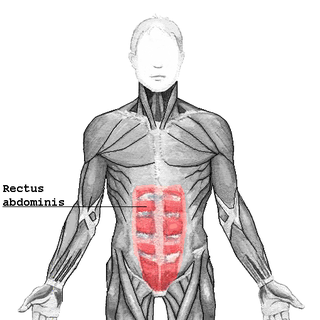
The jejunum is the second part of the small intestine in humans and most higher vertebrates, including mammals, reptiles, and birds. Its lining is specialised for the absorption by enterocytes of small nutrient molecules which have been previously digested by enzymes in the duodenum.

In human anatomy, the superior mesenteric artery (SMA) is an artery which arises from the anterior surface of the abdominal aorta, just inferior to the origin of the celiac trunk, and supplies blood to the intestine from the lower part of the duodenum through two-thirds of the transverse colon, as well as the pancreas.

SUNY Downstate Health Sciences University (Downstate) is a public medical school and hospital in Brooklyn, New York. It is the southernmost member of the State University of New York (SUNY) system and the only academic medical center for health education, research, and patient care serving Brooklyn's 2.5 million residents. As of Fall 2018, it had a total student body of 1,846 and approximately 8,000 faculty and staff.

The transverse abdominal muscle (TVA), also known as the transverse abdominis, transversalis muscle and transversus abdominis muscle, is a muscle layer of the anterior and lateral abdominal wall which is deep to the internal oblique muscle. It is thought by most fitness instructors to be a significant component of the core.

In human anatomy, the inferior mesenteric artery, often abbreviated as IMA, is the third main branch of the abdominal aorta and arises at the level of L3, supplying the large intestine from the distal transverse colon to the upper part of the anal canal. The regions supplied by the IMA are the descending colon, the sigmoid colon, and part of the rectum.

Downstate New York represents the southeastern portion of the U.S. state of New York, in contrast to Upstate New York, which comprises the more northerly and westerly portions of the state. The Downstate region, like Upstate New York, is divided into several subregions, such as New York City, the Lower Hudson Valley, and Long Island. The New York State Department of Transportation (NYSDOT) defines its "Downstate Region" as including Dutchess and Orange counties, and areas east and south; regions 9 and 10 of the inset map, plus the portions of region 8 south or east of the "8 label". Both agencies and the general public use varying definitions of the boundary between Upstate and Downstate.

In human anatomy, inferior epigastric artery refers to the artery that arises from the external iliac artery. It anastomoses with the superior epigastric artery. Along its course, it is accompanied by a similarly named vein, the inferior epigastric vein. These epigastric vessels form the lateral border of Hesselbach's triangle, which outlines the area through which direct inguinal hernias protrude.

The iliohypogastric nerve is a nerve that originates from the lumbar plexus that supplies sensation to skin over the lateral gluteal and hypogastric regions and motor to the internal oblique muscles and transverse abdominal muscles.

The duodenojejunal flexure or duodenojejunal junction is the border between the duodenum and the jejunum.

The medial umbilical ligament is a paired structure found in human anatomy. It is on the deep surface of the anterior abdominal wall, and is covered by the medial umbilical folds. It is different from the median umbilical ligament, a structure that represents the remnant of the embryonic urachus.

The mesosalpinx is part of the lining of the abdominal cavity in higher vertebrates, specifically the portion of the broad ligament that stretches from the ovary to the level of the fallopian tube.

The deep perineal pouch is the anatomic space enclosed in part by the perineum, and located superior to the perineal membrane.

The rectus sheath, also called the rectus fascia, is formed by the aponeuroses of the transverse abdominal and the internal and external oblique muscles. It contains the rectus abdominis and pyramidalis muscles.

The anterior divisions of the seventh, eighth, ninth, tenth, and eleventh thoracic intercostal nerves are continued anteriorly from the intercostal spaces into the abdominal wall; hence they are named thoraco-abdominal nerves.

The gastrosplenic ligament is part of the greater omentum.
Eli A. Friedman is an American nephrologist.

F. Charles Brunicardi is an American physician.
The SUNY Eye Institute (SEI) is a consortium of scientists from five campuses within the State University of New York. Participating institutions include four SUNY medical schools and the SUNY College of Optometry. The SEI was organized in 2007 and formally recognized by SUNY in 2009. Its aims are (1) to foster collaboration among SUNY research scientists in support of research on all aspects of visual function, with an emphasis on diseases of the human eye and their treatment, and (2) to enhance training in clinical and basic visual sciences in the U.S. State of New York. It receives financial support from SUNY through the SUNY REACH program.

Michael M. Meguid is Professor of Surgery Emeritus at Upstate Medical University, Syracuse, New York.

The SUNY Downstate Health Sciences University is a public medical school in New York City and one of the three components of SUNY Downstate Medical Center: University Hospital at Long Island College Hospital, SUNY Downstate at Bay Ridge, and University Hospital of Brooklyn in East Flatbush, whose staffing is provided by SUNY Downstate College of Medicine.


















